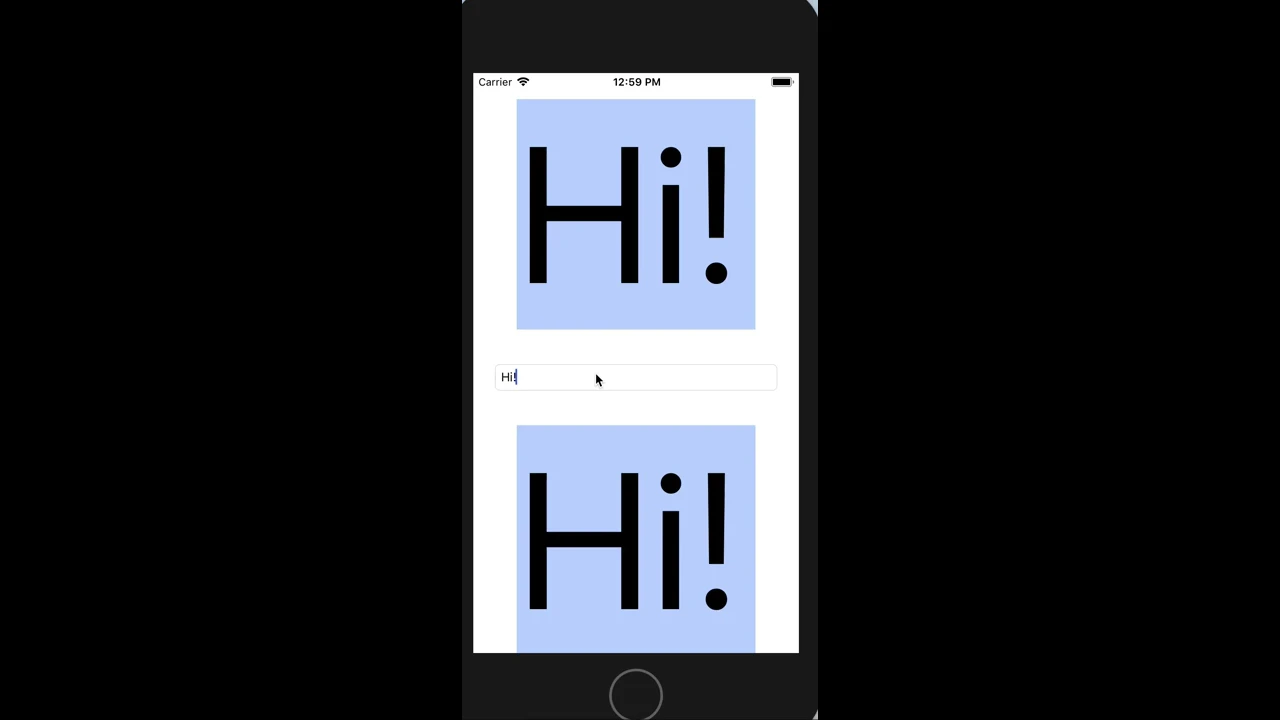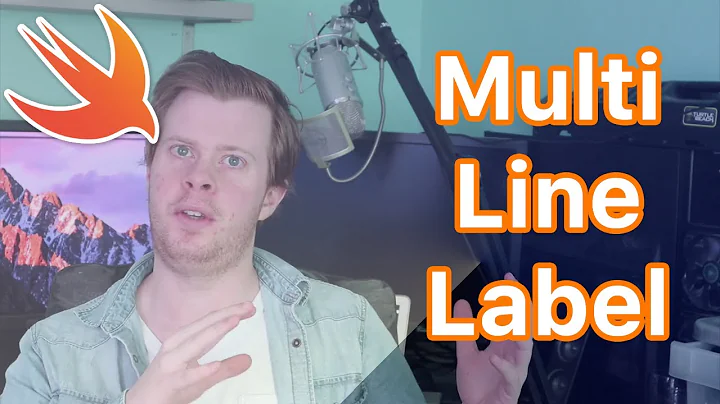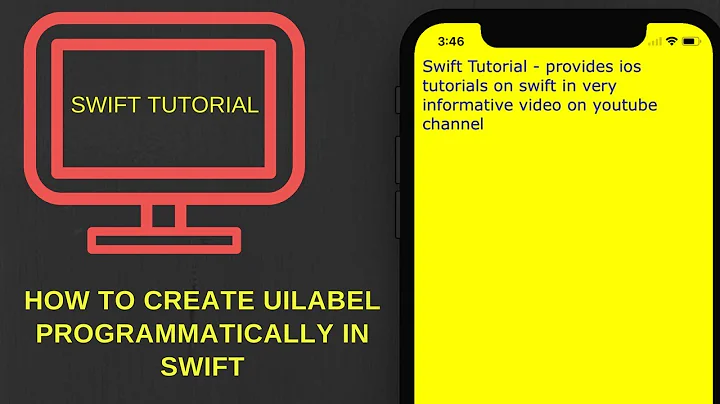Multiline UILabel with adjustsFontSizeToFitWidth
Solution 1
In this question, 0x90 provides a solution that - although a bit ugly - does what I want. Specifically, it deals correctly with the situation that a single word does not fit the width at the initial font size. I've slightly modified the code so that it works as a category on NSString:
- (CGFloat)fontSizeWithFont:(UIFont *)font constrainedToSize:(CGSize)size {
CGFloat fontSize = [font pointSize];
CGFloat height = [self sizeWithFont:font constrainedToSize:CGSizeMake(size.width,FLT_MAX) lineBreakMode:UILineBreakModeWordWrap].height;
UIFont *newFont = font;
//Reduce font size while too large, break if no height (empty string)
while (height > size.height && height != 0) {
fontSize--;
newFont = [UIFont fontWithName:font.fontName size:fontSize];
height = [self sizeWithFont:newFont constrainedToSize:CGSizeMake(size.width,FLT_MAX) lineBreakMode:UILineBreakModeWordWrap].height;
};
// Loop through words in string and resize to fit
for (NSString *word in [self componentsSeparatedByCharactersInSet:[NSCharacterSet whitespaceAndNewlineCharacterSet]]) {
CGFloat width = [word sizeWithFont:newFont].width;
while (width > size.width && width != 0) {
fontSize--;
newFont = [UIFont fontWithName:font.fontName size:fontSize];
width = [word sizeWithFont:newFont].width;
}
}
return fontSize;
}
To use it with a UILabel:
CGFloat fontSize = [label.text fontSizeWithFont:[UIFont boldSystemFontOfSize:15] constrainedToSize:label.frame.size];
label.font = [UIFont boldSystemFontOfSize:fontSize];
EDIT: Fixed the code to initialize newFont with font. Fixes a crash under certain circumstances.
Solution 2
In some cases, changing "Line Breaks" from "Word Wrap" to "Truncate Tail" may be all you need, if you know how many lines you want (e.g. "2"): Credit: Becky Hansmeyer
Solution 3
For a fully working solution, see the bottom of my answer 👇
To manually measure the dimensions of the text / attributedText of your UILabel in order to find the appropriate font size using your own strategy, you have a few options:
Use
NSString'ssize(withAttributes:)orNSAttributedString'ssize()function. These are only partially useful because they assume the text is one line.-
Use
NSAttributedString'sboundingRect()function, which takes a few drawing options, making sure you supply.usesLineFragmentOriginto support multiple lines:var textToMeasure = label.attributedText // Modify the font size in `textToMeasure` as necessary // Now measure let rect = textToMeasure.boundingRect(with: label.bounds, options: [. usesLineFragmentOrigin], context: nil) -
Use TextKit and your own NSLayoutManager:
var textToMeasure = label.attributedText // Modify the font size in `textToMeasure` as necessary // Now measure let layoutManager = NSLayoutManager() let textContainer = NSTextContainer(size: CGSize(width: label.bounds.width, height: .greatestFiniteMagnitude)) let textStorage = NSTextStorage(attributedString: string) textStorage.addLayoutManager(layoutManager) layoutManager.addTextContainer(textContainer) let glyphRange = layoutManager.glyphRange(for: textContainer) let rect = layoutManager.boundingRect(forGlyphRange: glyphRange, in: textContainer) Use CoreText, a more powerful and low-level API for laying out text. This would probably be unnecessarily complicated for this task.
Regardless of what you choose to use to measure text, you will probably need to do two passes: The first pass is to account for long words that should not be broken up over multiple lines, where you will need to find the largest font size that fits the largest (~longest) word fully within the label's bounds. In the second pass, you can continue your search downwards from the result of the first pass to find an even smaller font size as required to fit the entire text this time.
When doing the largest word measurement (rather than the entire text), you don't want to restrict the width parameter that you supply to some of the above sizing functions, otherwise the system will have no choice but to break up the single word you gave it and return incorrect results for your purposes. You will need to replace the width argument of the above methods with CGFloat.greatestFiniteMagnitude:
- the width part of the size argument of
boundingRect(). - the width part of the size argument of
NSTextContainer().
You will also need to consider the actual algorithm that you use for your search, since measuring text is an expensive operation and a linear search might be too slow, depending on your needs. If you want to be more efficient you can apply a binary search instead. 🚀
For a robust working solution based on the above, see my open-source framework AccessibilityKit. A couple of examples of AKLabel in action:


Hope this helps!
Solution 4
Thanks, with that and a little more from someone else I did this custom UILabel, that will respect the minimum font size and there's a bonus option to align the text to top.
h:
@interface EPCLabel : UILabel {
float originalPointSize;
CGSize originalSize;
}
@property (nonatomic, readwrite) BOOL alignTextOnTop;
@end
m:
#import "EPCLabel.h"
@implementation EPCLabel
@synthesize alignTextOnTop;
-(void)verticalAlignTop {
CGSize maximumSize = originalSize;
NSString *dateString = self.text;
UIFont *dateFont = self.font;
CGSize dateStringSize = [dateString sizeWithFont:dateFont
constrainedToSize:CGSizeMake(self.frame.size.width, maximumSize.height)
lineBreakMode:self.lineBreakMode];
CGRect dateFrame = CGRectMake(self.frame.origin.x, self.frame.origin.y, self.frame.size.width, dateStringSize.height);
self.frame = dateFrame;
}
- (CGFloat)fontSizeWithFont:(UIFont *)font constrainedToSize:(CGSize)size {
CGFloat fontSize = [font pointSize];
CGFloat height = [self.text sizeWithFont:font
constrainedToSize:CGSizeMake(size.width,FLT_MAX)
lineBreakMode:UILineBreakModeWordWrap].height;
UIFont *newFont = font;
//Reduce font size while too large, break if no height (empty string)
while (height > size.height && height != 0 && fontSize > self.minimumFontSize) {
fontSize--;
newFont = [UIFont fontWithName:font.fontName size:fontSize];
height = [self.text sizeWithFont:newFont
constrainedToSize:CGSizeMake(size.width,FLT_MAX)
lineBreakMode:UILineBreakModeWordWrap].height;
};
// Loop through words in string and resize to fit
if (fontSize > self.minimumFontSize) {
for (NSString *word in [self.text componentsSeparatedByString:@" "]) {
CGFloat width = [word sizeWithFont:newFont].width;
while (width > size.width && width != 0 && fontSize > self.minimumFontSize) {
fontSize--;
newFont = [UIFont fontWithName:font.fontName size:fontSize];
width = [word sizeWithFont:newFont].width;
}
}
}
return fontSize;
}
-(void)setText:(NSString *)text {
[super setText:text];
if (originalSize.height == 0) {
originalPointSize = self.font.pointSize;
originalSize = self.frame.size;
}
if (self.adjustsFontSizeToFitWidth && self.numberOfLines > 1) {
UIFont *origFont = [UIFont fontWithName:self.font.fontName size:originalPointSize];
self.font = [UIFont fontWithName:origFont.fontName size:[self fontSizeWithFont:origFont constrainedToSize:originalSize]];
}
if (self.alignTextOnTop) [self verticalAlignTop];
}
-(void)setAlignTextOnTop:(BOOL)flag {
alignTextOnTop = YES;
if (alignTextOnTop && self.text != nil)
[self verticalAlignTop];
}
@end
I hope it helps.
Solution 5
There is an ObjC extension provided in comments, that calculate fontsize required to fit multiline text into UILabel. It was rewritten in Swift (since it is 2016):
//
// NSString+KBAdditions.swift
//
// Created by Alexander Mayatsky on 16/03/16.
//
// Original code from http://stackoverflow.com/a/4383281/463892 & http://stackoverflow.com/a/18951386
//
import Foundation
import UIKit
protocol NSStringKBAdditions {
func fontSizeWithFont(font: UIFont, constrainedToSize size: CGSize, minimumScaleFactor: CGFloat) -> CGFloat
}
extension NSString : NSStringKBAdditions {
func fontSizeWithFont(font: UIFont, constrainedToSize size: CGSize, minimumScaleFactor: CGFloat) -> CGFloat {
var fontSize = font.pointSize
let minimumFontSize = fontSize * minimumScaleFactor
var attributedText = NSAttributedString(string: self as String, attributes:[NSFontAttributeName: font])
var height = attributedText.boundingRectWithSize(CGSize(width: size.width, height: CGFloat.max), options:NSStringDrawingOptions.UsesLineFragmentOrigin, context:nil).size.height
var newFont = font
//Reduce font size while too large, break if no height (empty string)
while (height > size.height && height != 0 && fontSize > minimumFontSize) {
fontSize--;
newFont = UIFont(name: font.fontName, size: fontSize)!
attributedText = NSAttributedString(string: self as String, attributes:[NSFontAttributeName: newFont])
height = attributedText.boundingRectWithSize(CGSize(width: size.width, height: CGFloat.max), options:NSStringDrawingOptions.UsesLineFragmentOrigin, context:nil).size.height
}
// Loop through words in string and resize to fit
for word in self.componentsSeparatedByCharactersInSet(NSCharacterSet.whitespaceAndNewlineCharacterSet()) {
var width = word.sizeWithAttributes([NSFontAttributeName:newFont]).width
while (width > size.width && width != 0 && fontSize > minimumFontSize) {
fontSize--
newFont = UIFont(name: font.fontName, size: fontSize)!
width = word.sizeWithAttributes([NSFontAttributeName:newFont]).width
}
}
return fontSize;
}
}
Link to full code: https://gist.github.com/amayatsky/e6125a2288cc2e4f1bbf
Related videos on Youtube
Ortwin Gentz
Head of FutureTap, developer of Where To? for iPhone and Streets for iPhone and iPad.
Updated on November 21, 2020Comments
-
Ortwin Gentz over 3 years
I have a multiline UILabel whose font size I'd like to adjust depending on the text length. The whole text should fit into the label's frame without truncating it.
Unfortunately, according to the documentation the
adjustsFontSizeToFitWidthproperty "is effective only when thenumberOfLinesproperty is set to 1".I tried to determine the adjusted font size using
-[NSString (CGSize)sizeWithFont:(UIFont *)font constrainedToSize:(CGSize)size lineBreakMode:(UILineBreakMode)lineBreakMode]and then decrementing the font size until it fits. Unfortunately, this method internally truncates the text to fit into the specified size and returns the size of the resulting truncated string.
-
Jilouc about 12 yearsI've found more accurate to use
[self componentsSeparatedByCharactersInSet:[NSCharacterSet whitespaceAndNewlineCharacterSet]]instead of just splitting by space. -
kevboh almost 12 yearsThis is great. I added support for minimum font size and a category on
UILabelfor convenience and uploaded it as a gist for anyone who's interested. -
 Klaas almost 12 yearsGreat method. You might consider adding the line break mode as another parameter.
Klaas almost 12 yearsGreat method. You might consider adding the line break mode as another parameter. -
Duane Fields about 11 yearsWith all these approaches however, if your text won't fit into the specified number of lines at the starting (now maximum) font size, the constrainedToSize call happily truncates the text for you based on your line break, in order to fit the width. thus you end up shrinking only to fit whatever was left, rather than what I think you really want, which is "shrink to fit all this text into n-number of lines"
-
 RanLearns about 11 yearsHow do you make use of this fontSizeWithFont method so you can call it in your .m implementation on a UILabel? I'm getting "No visible @interface for 'NSString' declares the selector 'sizeWithFont:constrainedToSize:'"
RanLearns about 11 yearsHow do you make use of this fontSizeWithFont method so you can call it in your .m implementation on a UILabel? I'm getting "No visible @interface for 'NSString' declares the selector 'sizeWithFont:constrainedToSize:'" -
Ortwin Gentz about 11 years@ObjectiveFlash, create a category on NSString with the method in it, then #import the category where you need it.
-
 RanLearns about 11 yearsNot sure if I'm doing it the way you are, but after some more searching I found a way that works! In the header file, after the "end" of the '@interface', create another '"@interface NSString (NSStringAdditions)"' with the fontSizeWithFont:constrainedToSize: method in it, and then create an '"@implementation NSString (NSStringAdditions)"' in the .m of the viewController where you need to use this, after the "end" of the main '@implementation'
RanLearns about 11 yearsNot sure if I'm doing it the way you are, but after some more searching I found a way that works! In the header file, after the "end" of the '@interface', create another '"@interface NSString (NSStringAdditions)"' with the fontSizeWithFont:constrainedToSize: method in it, and then create an '"@implementation NSString (NSStringAdditions)"' in the .m of the viewController where you need to use this, after the "end" of the main '@implementation' -
Ortwin Gentz about 11 years@ObjectiveFlash, certainly possible albeit not the best style. Usually you'd put it in an extra NSString+Additions.h/.m file. Then you can import it anywhere you need it.
-
coneybeare almost 11 yearsthese methods are deprecated in iOS[REDACTED]
-
RyanG over 10 yearsI tried converting this to be iOS 7 friendly but I cannot get the same results. Does anything have a similar meted for iOS 7?







